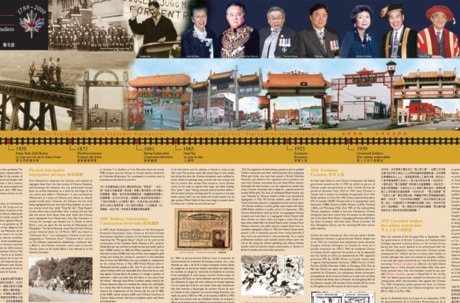After getting a showing in Parliament on Oct. 6, a poster-sized chart summarizing Chinese Canadian history from 1788 to the present day had its Victoria debut recently with an audience including several prominent community leaders of Chinese descent.
Project author and Saanich resident David Lai drew on his lifetime of studies of Chinese immigration and settlement in Canada to produce the chart.
“Dr. Lai needs no introduction – he is, after all, Mr. Chinatown,” said emcee Grace Wong Sneddon about the 35-year University of Victoria professor emeritus of geography, who has surveyed more than 40 Chinatowns in North America and Australia in his career.
Lai addressed the attendees, including senator and project patron Vivienne Poy and Oak Bay-Gordon Head MLA Ida Chong, with his typical humour. Turning down the lights for a slideshow presentation, he sent this invitation: “If you feel sleepy, you can doze. I will wake you up after.”
Using a railroad as a visual to ground the timeline, Lai’s chart begins with the first Chinese labourers, brought by the British to build a fortress in Nootka Sound. It ends with the 2006 apology by Parliament for the discrimination faced by Chinese immigrants who paid a head tax.
Victoria plays a central role in the national story of Chinese Canadian heritage as the first landing point, in the early days of the Fraser River gold rush.
With the introduction of the head tax in 1885, Chinese immigrants coming from Hong Kong were taken to an immigration office in Victoria, resembling a prison, where they had to wait until they or their relatives could produce the head tax. Years ago, Lai investigated the abandoned office. “I discovered some Chinese started to scratch some writing on the wall,” he said.
The chart project, launched by the David Lam Centre at Simon Fraser University, was first done 10 years ago, said David Choi, the centre’s adjunct professor. “This (version) has been completely revised and rewritten,” he said. Also new this time around, are booklets for each of Canada’s significant Chinatowns. They’ll be launched in cities across Canada in the months to come.
rholmen@vicnews.com
